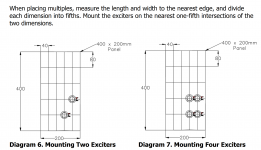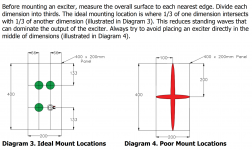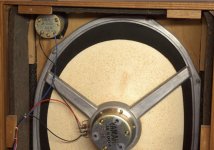The funniest claims that one of their DMLs shaped like to United States sounds better than a DML shaped like Italy.
They are intended to be run mono
Must give that a try. Or, a couple of panels running mono in a room.
They stated one panel in a room in mono... remember the are instruments not transducers. Interesting design for sure. I also wondered how they are using movable exciters (tickler?) to place braces on their panels
Another instrument using Monacor branded exciters.
Metallik Resonator 60cm | eowave
Metallik Resonator 50cm | eowave
Metallik Resonator 60cm | eowave
Metallik Resonator 50cm | eowave
The funniest claims that one of their DMLs shaped like to United States sounds better than a DML shaped like Italy.
If you add in Hawaii to the United States panel I believe it becomes a 2 way design and sounds even better!
Davelang.
Cardboard is one of my favourite panel materials ,good clean sound,and good frequency response from a small panel.
Must get back to experimenting with these,especially when they are so cheep and mostly free.
Steve
Cardboard is one of my favourite panel materials ,good clean sound,and good frequency response from a small panel.
Must get back to experimenting with these,especially when they are so cheep and mostly free.
Steve
Anie.
There are plenty of 8ohm exciters out the, digikey sell pui exciters in 8ohm ,it's probably the cheapest option.
Steve
There are plenty of 8ohm exciters out the, digikey sell pui exciters in 8ohm ,it's probably the cheapest option.
Steve
I have been thinking about the Dayton exciters. They are 4 ohm and amplifiers in common are designed for 6-8 ohms, like my Yamaha amp. How to think about to put two exciters on a birch ply panel, or two ply panels with one exciter at each (four panels totally) in series to get 8 ohms.
ANIE,
Personally I have found that using a pair of 4 ohm exciters on the same panel, wired in series to get 8 ohms, can work just fine. I would highly recommend trying many combinations of locations before attaching them permanently. When you find the right pair of locations you can get better frequency response than with a single exciter. But with the wrong pair of locations, you can get worse. So try several places. One set of locations that I have found to often work well is with both exciters close to the center of the panel but diagonally opposite each other.
Eric
Blocked
If you are going to use two of more exciters,reading this might help.
I have not tried these exciter positions so I cannot say how successful they are at reducing the comb filtering,A major problem when two exciters(and standard drivers)are used in close proximity,they also don't show the results?
Hope this is of some help.
Steve
If you are going to use two of more exciters,reading this might help.
I have not tried these exciter positions so I cannot say how successful they are at reducing the comb filtering,A major problem when two exciters(and standard drivers)are used in close proximity,they also don't show the results?
Hope this is of some help.
Steve
Blocked
If you are going to use two of more exciters,reading this might help.
I have not tried these exciter positions so I cannot say how successful they are at reducing the comb filtering,A major problem when two exciters(and standard drivers)are used in close proximity,they also don't show the results?
Hope this is of some help.
Steve
Good link
Attachments
Yamaha NS Speakers
I've had it in mind to use the shape of the vintage Yamaha NS series JA6002 driver, for my next panels. I wanted to share a link to a guy in Japan who is thoroughly into the sound of these speakers. I think he has 10 of them in various configurations.
A few things I have gleaned from his writings about them:
- The big driver is facing backwards in the back end of the baffle, but wired out of phase with the mid and tweeter.
- Felt is used over the voice coil area of the panel.
- Even though they are often referred to as elephant ear speakers, the inspiration comes from a piano soundboard.
- The perimeter of the panel is rigidly mounted.
- It is very efficient, has highs to 10k and is wired full range.
- He has some cool analogies of the speaker's sound vs a conventional (large fan vs small fan, bright LED vs a diffuse flood lamp).
His enthusiasm is infectious!
I'd appreciate your thoughts on his observations and the NS design. Thanks!
Please note there are around 6 parts to his monologue.
Google Translate
I've had it in mind to use the shape of the vintage Yamaha NS series JA6002 driver, for my next panels. I wanted to share a link to a guy in Japan who is thoroughly into the sound of these speakers. I think he has 10 of them in various configurations.
A few things I have gleaned from his writings about them:
- The big driver is facing backwards in the back end of the baffle, but wired out of phase with the mid and tweeter.
- Felt is used over the voice coil area of the panel.
- Even though they are often referred to as elephant ear speakers, the inspiration comes from a piano soundboard.
- The perimeter of the panel is rigidly mounted.
- It is very efficient, has highs to 10k and is wired full range.
- He has some cool analogies of the speaker's sound vs a conventional (large fan vs small fan, bright LED vs a diffuse flood lamp).
His enthusiasm is infectious!
I'd appreciate your thoughts on his observations and the NS design. Thanks!
Please note there are around 6 parts to his monologue.
Google Translate
Last edited:
Bdjohns.
Thanks for this posting ,very interesting,my dad's first organ had one of these beasts inside ,I used to drool over it ,dreaming of ripping it out for my own use.
My dad wouldn't have been very pleased,but if only!
The things he says in his blog,are very similar to the things I say about my polystyrene panels,and his recording sounds very good,except for those noisy insects,which would drive me mad.
I have only read 2 blogs +links but will read the rest in time.
Sorry I lost the patent that had the various shapes with measurements plus ending with the ear shape 🙁
Steve
Thanks for this posting ,very interesting,my dad's first organ had one of these beasts inside ,I used to drool over it ,dreaming of ripping it out for my own use.
My dad wouldn't have been very pleased,but if only!
The things he says in his blog,are very similar to the things I say about my polystyrene panels,and his recording sounds very good,except for those noisy insects,which would drive me mad.
I have only read 2 blogs +links but will read the rest in time.
Sorry I lost the patent that had the various shapes with measurements plus ending with the ear shape 🙁
Steve
Great find, Steve. I see the description says the polystyrene is molded with an epoxy binder. Guess I won't be getting any of that at the hardware store!
Vintage 1969 Elephant Ear YAMAHA JA4001 Speaker. for Sale - Mattsmusicpage
One of the shapes for the dml panels in the patent I can't find,was similar to this,and had a similar response as the elephant ear shape.
Slightly altering a 2x4ft panel so the sides are not parallel could be a good alternative?
Steve
One of the shapes for the dml panels in the patent I can't find,was similar to this,and had a similar response as the elephant ear shape.
Slightly altering a 2x4ft panel so the sides are not parallel could be a good alternative?
Steve
- Home
- Loudspeakers
- Full Range
- A Study of DMLs as a Full Range Speaker


